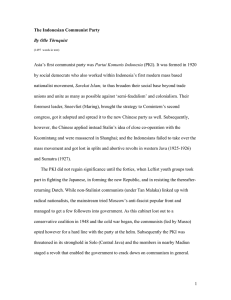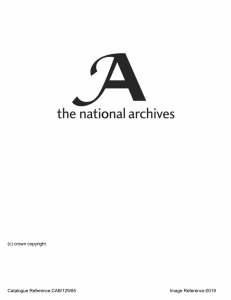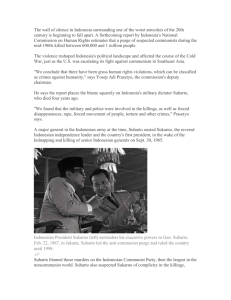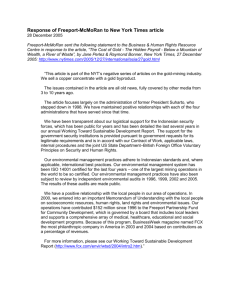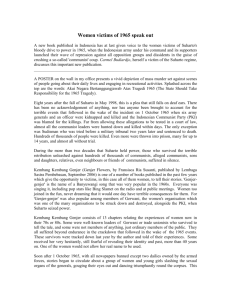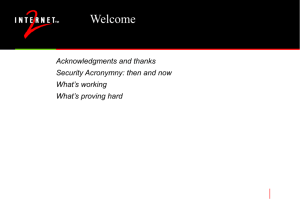Corrected review article (1503 words), dated 19/4/07, by Olle Törnquist,... University of Wisconsin Press, 2006. International Review of Social History,
advertisement
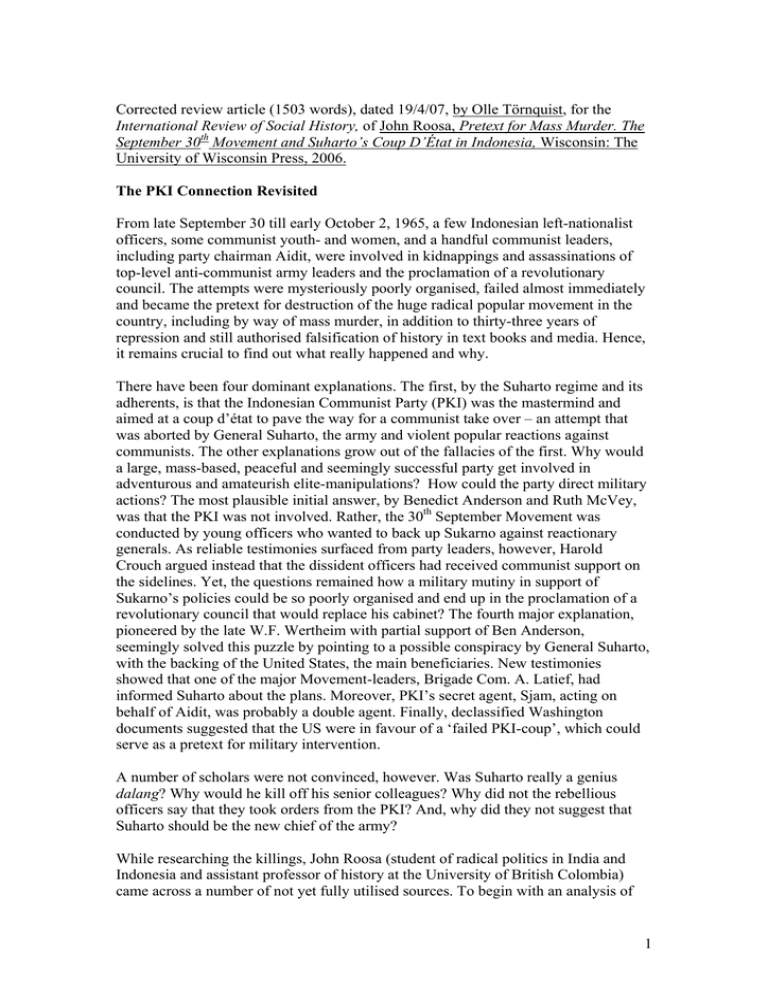
Corrected review article (1503 words), dated 19/4/07, by Olle Törnquist, for the International Review of Social History, of John Roosa, Pretext for Mass Murder. The September 30th Movement and Suharto’s Coup D’État in Indonesia, Wisconsin: The University of Wisconsin Press, 2006. The PKI Connection Revisited From late September 30 till early October 2, 1965, a few Indonesian left-nationalist officers, some communist youth- and women, and a handful communist leaders, including party chairman Aidit, were involved in kidnappings and assassinations of top-level anti-communist army leaders and the proclamation of a revolutionary council. The attempts were mysteriously poorly organised, failed almost immediately and became the pretext for destruction of the huge radical popular movement in the country, including by way of mass murder, in addition to thirty-three years of repression and still authorised falsification of history in text books and media. Hence, it remains crucial to find out what really happened and why. There have been four dominant explanations. The first, by the Suharto regime and its adherents, is that the Indonesian Communist Party (PKI) was the mastermind and aimed at a coup d’état to pave the way for a communist take over – an attempt that was aborted by General Suharto, the army and violent popular reactions against communists. The other explanations grow out of the fallacies of the first. Why would a large, mass-based, peaceful and seemingly successful party get involved in adventurous and amateurish elite-manipulations? How could the party direct military actions? The most plausible initial answer, by Benedict Anderson and Ruth McVey, was that the PKI was not involved. Rather, the 30th September Movement was conducted by young officers who wanted to back up Sukarno against reactionary generals. As reliable testimonies surfaced from party leaders, however, Harold Crouch argued instead that the dissident officers had received communist support on the sidelines. Yet, the questions remained how a military mutiny in support of Sukarno’s policies could be so poorly organised and end up in the proclamation of a revolutionary council that would replace his cabinet? The fourth major explanation, pioneered by the late W.F. Wertheim with partial support of Ben Anderson, seemingly solved this puzzle by pointing to a possible conspiracy by General Suharto, with the backing of the United States, the main beneficiaries. New testimonies showed that one of the major Movement-leaders, Brigade Com. A. Latief, had informed Suharto about the plans. Moreover, PKI’s secret agent, Sjam, acting on behalf of Aidit, was probably a double agent. Finally, declassified Washington documents suggested that the US were in favour of a ‘failed PKI-coup’, which could serve as a pretext for military intervention. A number of scholars were not convinced, however. Was Suharto really a genius dalang? Why would he kill off his senior colleagues? Why did not the rebellious officers say that they took orders from the PKI? And, why did they not suggest that Suharto should be the new chief of the army? While researching the killings, John Roosa (student of radical politics in India and Indonesia and assistant professor of history at the University of British Colombia) came across a number of not yet fully utilised sources. To begin with an analysis of 1 the senior officer involved, Brig. Gen. Supardjo, to which was added interviews with a leading PKI member with privileged knowledge of its special bureau and director. Further, a number of statements by PKI-leaders, declassified US materials, an analysis by the late Siauw Giok Tjhan (former leader of the Indonesian ethnic Chinese) based on conversations with imprisoned PKI-leaders, and interviews with eight particularly knowledgeable leftists. What did these sources indicate? The new narration may be summarised in three theses. First, that while the 30th September Movement emerged as a dissident military group, its actions were guided by the PKI chairman Aidit through the party’s special bureau; a secret remnant within the party’s organisational department from the clandestine work in the late forties and since some time headed by Sjam, an old confident of Aidit from this period of revolutionary, elitist-cadre actions. Second, that while this special bureau – just like many similarly secret units in other parties and groups at the time – primarily gathered supporters within the armed forces, it was also called upon by Aidit in mid-1965 to guide dissident officers who wanted to prevent top-generals from sabotaging Sukarno’s policies. The officers should be guided in such a way that their mutiny would not be limited to a military affair – which had recently been the case in Algeria by Col. Boumedienne against Ben Bella – but pave the way for popular mobilisation in favour of more consistent implementation of Sukarno’s radical intentions. By necessity, such leadership had to be secret, to save the party should anything go wrong and to prevent disclosure by ‘unreliable’ top-party leaders such as Njoto and Sakirman. Third, that there was no genius mastermind behind the Movement. Rather, the organisation and actions were quite messy. The combination of secret guidance by a few party-leaders and a majority of officers who did not want to go beyond the exposure of their reactionary superiors was a major reason for the lack of realistic planning, clear chains of command and food for the soldiers – as well as the fact that when things went wrong, some wanted to retreat, others discussed air-strikes against enemy-generals and yet others tried to ignite notoriously over-estimated military and mass support by proclaiming a revolutionary council. Are these disturbing revelations for leftists, which will lead to much needed rethinking while also being abused by proponents of the argument that the 30th of September Movement was a PKI ploy to grab power? I do not think so. To begin with, Roosa’s study also reveals a number of disturbing facts for the previous and current Indonesian regimes. The scrupulous and instigating role of the US is well documented. Suharto’s manipulations are clear enough. It is proven that there was no mastermind – and that the PKI was not involved as a party and movement, only through some few leaders acting secretly beyond their mandates. It is established that the 30th September movement was used as a pretext for Suharto’ disobedience of President Sukarno, rise to power and quite separately organised repression with massive executions and instigation of militia-like mass murders, (the logics of which we know better now from the organisation of the post-Suharto violence in Indonesia itself and East Timor). 2 Moreover, a previous study that arrived at almost the same conclusions did not generate much attention by the Left, which appeared to largely suppress mistakes that did not fit into a Moist reading. Not even Roosa himself seems to be aware of the earlier results, published some twenty-five years ago (in English by Zed Books in 1984). That study (by this author) on the destruction of the PKI was primarily based on theoretical and comparative readings of the longer historical perspective; a perspective revealing that PKI was only visibly successful, that its major strategies of anti-imperialism and land reform had partially backfired, that it had abandoned democratic elections and that it was thus in need of elite manipulations to advance. In its eighteenth chapter, moreover, the study utilised some of the sources that Roosa draws on, including about Aidit’s conclusions about the coup in Algeria. However, Roosa’s important contribution is in the details, by which he expands firmly on previous less comprehensive and less well substantiated conclusions. Most crucially, he proves that the 30th September movement was a miserably messy affair with many aims and actors but few firmly applied organisational principles. This, I’m afraid, reminds more of the militant youth groups during the national revolution, or the fragmented pro-democrats of today, than of a coherent party that is kept accountable by members and broad mass organisations. Indeed, one might have wished a more extensive discussion of the possible biases of some of the sources due to their harsh feelings against Aidit, including the major informant on the role of Aidit, Sjam and PKI’s special bureau; an informant who in passing is identified as ‘a follower of the Maoist line on armed struggle’ (p.137). One may also wonder why an historian has not made use of a longer historical perspective (that could have been based on already existing literature) to thus place his sources and pieces of oral history in context and improve the interpretation of them. Similarly, several additional factors that affected the 30th of September movement remain to be added; for instance why Suharto did not act swiftly against the dissidents but waited until it was clear that Sukarno had not appointed him the new chief of the army. Even later in the afternoon, General Nasution, Suharto’s senior and minister of defence who had escaped arrest and assignation, was stunned by his indecisiveness, (interview with this author in 1980). In general conclusion, however, Roosa’s account of the 30th of September movement is an impressive piece of detective work. It is true that he does not venture into the historical puzzle of why a few leaders of the third largest communist party in the world got associated with the 30th of September Movement in the first place. But he has certainly contributed the best study hitherto of who organised it, why it failed and how it could lead to mass killings, followed by decades of repression. It deserves widest possible reading. /end 3
